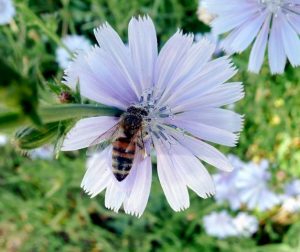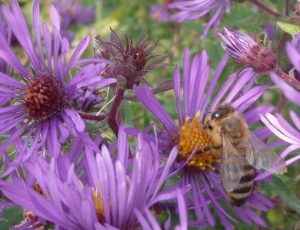Live from the Hive: December 2013
“Celebrating the Bees” By Annie Watson
The first snow is on the ground. It was 16 degrees this morning here in the Champlain Valley. Inside the hive, the bees have massed into a ball to keep themselves warm. Now comes the time when we trust that they can withstand the cold weather of the year. We too withdraw to the indoors as the days of gratitude and celebration come upon us. Barr Hill Gin, Vodka, and Elderberry cordial help to keep us warm and remind us of the astonishing work the bees do every year. Without the honey bee, we could not make our wonderful products, which are outstanding because of the honey they contain. We are truly grateful for the bees.
 We had long warm fall, which allowed the bees to forage late into October. On many days the temperature got well above 60 degrees, allowing the bees to fly, and, we hope, make more honey to prepare for the winter.
We had long warm fall, which allowed the bees to forage late into October. On many days the temperature got well above 60 degrees, allowing the bees to fly, and, we hope, make more honey to prepare for the winter. This is a great year for our native purple New England Aster (Aster novae-angliae) . These perennial flowers provide beautiful fall color in our meadows, hedgerows and roadsides, and food for many creatures including bees and other insects, wild turkeys, deer, and rabbits. The flower petals can be purple, lavender, or light pink in color, while the central disk florets are yellow or gold — the complementary color for purple. When two complementary colors are put next to each other, each color “pops”: The purple looks more purple and the gold looks more gold. This is the last big summer flower to give food for the honeybees. The honey made from these flowers has a hint of spice in its flavor and it crystallizes very quickly in the comb. The flower itself exudes a subtle spicy scent.
This is a great year for our native purple New England Aster (Aster novae-angliae) . These perennial flowers provide beautiful fall color in our meadows, hedgerows and roadsides, and food for many creatures including bees and other insects, wild turkeys, deer, and rabbits. The flower petals can be purple, lavender, or light pink in color, while the central disk florets are yellow or gold — the complementary color for purple. When two complementary colors are put next to each other, each color “pops”: The purple looks more purple and the gold looks more gold. This is the last big summer flower to give food for the honeybees. The honey made from these flowers has a hint of spice in its flavor and it crystallizes very quickly in the comb. The flower itself exudes a subtle spicy scent.